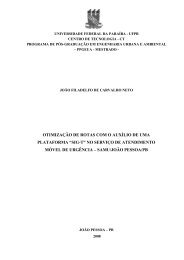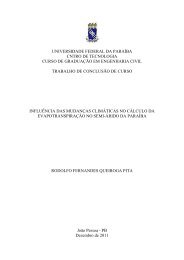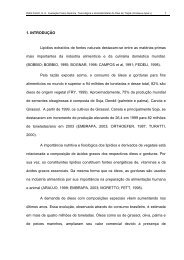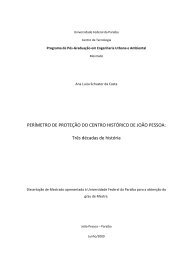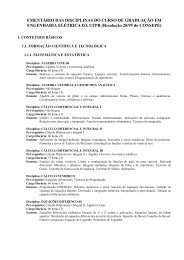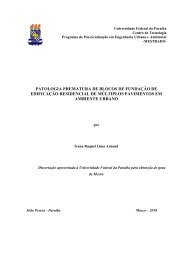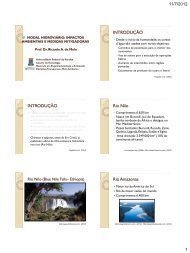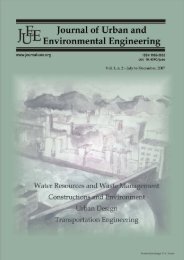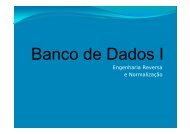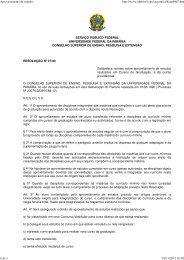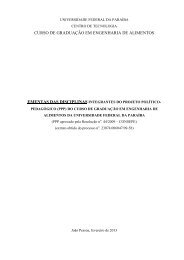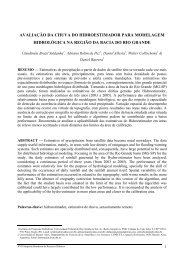editorial team
editorial team
editorial team
Create successful ePaper yourself
Turn your PDF publications into a flip-book with our unique Google optimized e-Paper software.
Bennajah, Maalmi, Darmane and Touhami<br />
41<br />
Fig. 2 Non linear representation of the three adsorption models.<br />
Hu et al. (2008) limited their VOK model to the<br />
particular situation in which q e could be fitted using<br />
Langmuir isotherm. This approach was tested, but<br />
again, it did not fit the experimental data of Essadki et<br />
al. (2009). It must be reminded that Hu et al. (2008), as<br />
Emamjomeh & Sivakumar (2006), used small<br />
laboratory electrolytic cells with magnetic stirring,<br />
whereas a 20 L mechanically stirred reactor was used in<br />
this work. This may explain why their and our results do<br />
not agree.<br />
Similar trends were, however, observed when the<br />
Freundlich isotherm was introduced in Eq. (10), even<br />
though it was retained in Section 1.1: neither Langmuir,<br />
nor Freundlich isotherms were able to represent<br />
adequately the experimental results. Another difference<br />
with the literature was that the S/V ratio was lower both<br />
in the Airlift and the STR (0.875 m 2 m -3 ) than in the<br />
conventional EC cells in which the S/V ratio ranged<br />
between 10 and 40 m 2 m -3 (Mameri et al., 2001; Hu et<br />
al., 2005). At high S/V ratios, Zhu et al. (2007)<br />
demonstrated that fluoride adsorption/attachment on the<br />
electrode was primarily responsible for defluoridation<br />
efficiency, while other mechanisms played only a<br />
secondary role.<br />
Conversely, fluoride removal by attachment on the<br />
electrodes was negligible when S/V = 0.875 m 2 m -3 and<br />
the prevailing mechanisms were in the bulk, i.e. the<br />
simultaneous formation of soluble fluoroaluminium<br />
compounds, their coprecipitation with Al(OH) 3 and the<br />
simultaneous adsorption of fluoride anions on the<br />
insoluble species.<br />
This may also explain why the conventional<br />
isotherms are not able to fit experimental data, as the<br />
quantity of adsorbent was close to zero at the beginning<br />
of EC in the STR, while it was not negligible due to<br />
electrode attachment at high S/V ratio. As a result, only<br />
the VOK model based on the Langmuir–Freundlich<br />
isotherm will be developed in this section.<br />
Variable Order Kinetic approach (ALR)<br />
The kinetics of the defluoridation by electrcoagulation<br />
in (ALR) needs to be examined for estimating the time<br />
required for defluoridation. This kinetics was<br />
established by some authors in stirred reactor, they<br />
agreed roughly on the following expression (Mameri et<br />
al., 1998):<br />
[F] = [F] 0 e (-k ¹ t) (10)<br />
where, k 1 represents the first-order rate constant.<br />
However, the kinetic constant k 1 was reported to depend<br />
on the initial fluoride concentration, current and<br />
electrode distances for a constant temperature and pH.<br />
On the other hand, Hu et al. (2008) proposed a variable<br />
order kinetic (VOK) based on Langmuir isotherm in<br />
order to estimate the time required to defluoridation by<br />
EC in a 1L stirred cell.<br />
Our experimental results were firstly confronted to<br />
the VOK with Langmuir model, and to the VOK with<br />
Freundlich model, but neither fitted well the<br />
experimental results. In this work, we consider that<br />
Journal of Urban and Environmental Engineering (JUEE), v.4, n.1, p.36-44, 2010



